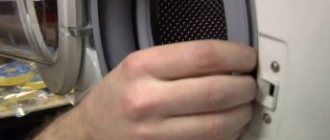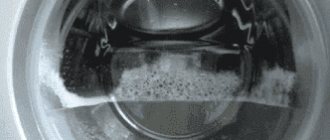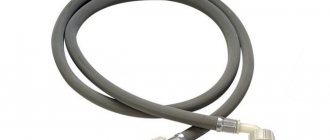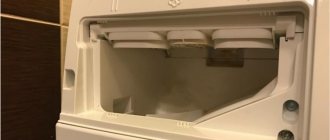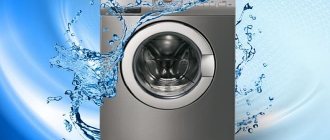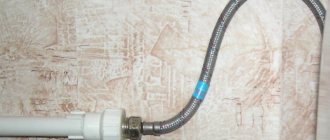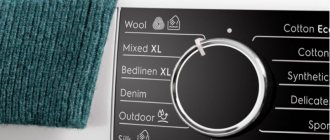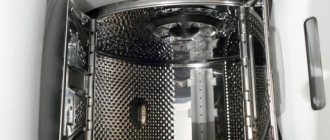During operation, any washing machine makes certain sounds, even if it is new and correctly installed. And this is the norm. The noise level depends to one degree or another on the manufacturer of the equipment. And it cannot be completely excluded. Another thing is when the washing machine makes a loud noise when draining water. This always indicates some kind of malfunction in the operation of the equipment.
If your washing machine stops working or there are strange noises and grinding noises when rinsing and draining, contact FixWasher. Our technician will quickly and efficiently diagnose and repair your washing machine at home in Moscow and the Moscow region. You can leave a request on the website or by phone. We work from 7:00 to 23:00 without breaks and weekends.
What buzzes in the washing machine when the water is draining?
The machine drains the water using a special pump. And if the sound of the machine during draining has changed, additional noise, crackling, or grinding noises have appeared, then the cause of the malfunction is located in the drain system. The most common causes of drainage system breakdowns are:
- Drain filter clogged.
- Clogged drain hose and pipes.
- Pump malfunction.
- Pump clogged.
- Foreign objects inside the car tank.
- Incorrect installation of the machine.
Normal noise level when washing
It is important to understand that the washing machine is not silent. In addition to the hum when the drum rotates, it makes many other sounds:
- the splash of running water when filling and draining;
- noise of the heating element and the water heated by it;
- sound of the drain pump;
- Clicks when switching operations.
Therefore, the presence of noise in itself is not a warning sign. You should be alerted if its volume has noticeably increased or extraneous sounds have appeared that were not there before.
In addition, do not confuse breakdowns with a normal increase in volume during spinning. During this operation, the drum rotates more intensely and the noise level increases. If during washing the volume of modern models is 54-59 dB, then during spinning it is 74-78 dB.
Drain filter clogged
The most common cause of loud noise when draining is a clogged drain filter. Most washing machines have a filter located at the bottom right. Some models have a lid that is easy to open by hand. In some models it is located behind a small panel that is secured with latches. You can remove it using a thin knife or screwdriver. To do this, you need to insert a tool into the slot and unfasten the latches. Next you need to check the drain filter.
- You need to put a thick rag under the machine so that the water does not spread when you pull out the filter.
- Unscrew the filter counterclockwise. If you can’t easily unscrew it, then you will have to pull it out along with the pump from the inside. It is better to entrust such manipulation to a master.
- If the filter is pulled out. You need to clean it with your hands from large debris.
- Use a soft brush and detergent to rinse the filter under running water.
- Inspect the filter hole with a flashlight. If there is debris there, clean that too.
- Put the filter back. Screw clockwise until it stops. There is no need to tighten too much to avoid stripping the threads.
- Next, we run a test washing program to check whether the hum has disappeared.
If, upon visual inspection of the filter, there was almost no debris in it, and a test run revealed that the hum did not stop, then most likely the cause of the noise when draining does not lie in the filter. And we need to look further.
Worn pulley or drive belt
If a belt-driven device is being considered, another reason why the washing machine is noisy during operation may be wear and tear on the rotation transmission system, namely: a loose pulley or worn out belt. To eliminate the noise in this case, you will have to partially disassemble the machine.
- The back cover is removed, it is held on by several bolts or screws.
- The big wheel just in the middle of the washing machine is the pulley. It must be carefully inspected, checked by hand for the presence of play. If the pulley “goes” there is nothing left to do but replace it.
- The belt is thrown over the pulley. It must be removed and inspected most carefully. In case of severe wear, signs of delamination, cracks, the belt is replaced.
It is also worth paying attention to the condition of the drum shaft. If the pulley has been poorly secured for a long time, wear may form on the shaft.
Drain hose clogged
The next step is to check the drain hose. This is a more complicated matter, which involves disassembling the machine body. After disassembling the housing, it is necessary to remove one end of the drain hose from the pump and pull the other out of the drain hole of the sewer pipe.
Visually inspect the hose from the outside. Use a special brush to clean the inside of the hose under running water. In this case, you need to pay attention that you cannot use a metal brush, because... the hose may be damaged. If the hose is not damaged and cleaned, it can be returned to its place. If you find damage to the hose, it must be replaced.
You need to immediately inspect and clean the drain pipe. If damage is found in it, it must also be replaced.
If your actions do not eliminate the extraneous noise or hum, then the problem is with the pump.
Weakened counterweights
By analogy with the previous problem, the issue of weakened counterweights is also solved. You must open access to the bolts and tighten them, after which the extraneous noise from the washing machine should disappear.
There may be another type of failure associated with counterweights - their complete destruction. In this case, the sound will be much louder and broken parts will have to be replaced.
How to tighten the counterweight fastenings is described in the video lessons:
Tightening the Upper Counterweight
Tightening the lower counterweight
Drain pump failure
With prolonged use of the washing machine, the drain pump wears out and its parts exhaust their service life. Its performance decreases, and during operation the machine does not drain water and hums. But the pump can fail if a foreign object gets into it.
Different manufacturers of household appliances remove pumps in different ways. In order to remove it correctly, you need to read the instructions in advance. Manufacturers always describe in detail how this can be done. If the pump fails, it must be replaced. A service center technician can diagnose and replace the part.
What noises should alert you?
In addition to volume, noise has another parameter - its character. That is, pitch, presence or absence of rhythm
If the level of sound produced by the machine exceeds the norm, then pay attention to what it is:
- whistling, buzzing;
- rattling.
For a rotating body, which is a drum with wet laundry, whistling and humming is the norm, but under certain conditions. The fact is that under the influence of centrifugal force, air begins to escape from under the casing of the machine. Penetrating into the cracks, it causes their edges to vibrate, which generates a peculiar melody for several voices. You should be wary when this “song” begins to be replaced by sounds of the same tone or a rhythm appears in it.
High pitch whistle
A phenomenon very familiar to car enthusiasts. As soon as one of the drive belts - the generator, the air conditioner - loosens, the car begins to squeal. There is no other way to describe this hysterical sound.
Almost all washing machines have a belt drive, only some, LG, for example, are equipped with a direct one - the motor is located on the axis of the drum.
Low frequency bass hum
May indicate one of two malfunctions:
- Destruction of the bearing on the drum axis.
- Breakdown of the electric motor winding.
The sound of a faulty bearing is very characteristic. It is similar to the humming of a bumblebee, and in severe cases, when destruction has already begun, metallic grinding and ringing is added to it.
If the electric motor is faulty, the hum is more monotonous and bassy. In addition, it is accompanied by the smell of burnt insulation and is not that loud.
Rhythm
Appears when the drum rotates unevenly or encounters an obstacle in its path. The cause may be an incorrectly installed or poor-quality sealing collar of the loading hatch. Or keys, metal money, or other artifacts that have fallen out of pockets.
Knocking and rattling
Indicate excessive vibration loads. There are several reasons for their occurrence:
- Machine overload. The center of gravity of the loaded laundry is moving or too close to the edge of the drum.
- Shock absorbers do not work.
- The counterweights are loose.
- Incorrect installation.
Sorting laundry before loading is a very important procedure. You cannot put things together that have fundamentally different sizes - for example, a duvet cover and underpants. And also those that absorb water differently.
The drum of the machine is attached to the body on shock absorbers. In the store they are in the transport position - clamps are inserted into them.
Counterweights - stones on both sides of the drum, are attached to bolts, which can become loose during long-term use.
Foreign object stuck
In some cases, it happens that the formation of a hum when draining occurs due to the fact that a foreign object is stuck in the machine. Most often this item is a bra wire. It easily fits into the drum holes and can get stuck anywhere in the machine. Various small parts of clothing (buttons, rhinestones, beads, snaps and pins) can also get stuck. Or the contents of pockets that you forgot to check (bolts, nuts, nails, as well as money, documents, etc. small things) may also end up in the wrong place. And of course small things such as socks, handkerchiefs.
Small objects like these can get wrapped around the pump impeller, making it difficult to operate. If any of the above items are in the drain filter or pump nozzle, the machine will have difficulty draining water, and the pump will hum loudly from excessive force.
The noisiest stage
The question most often arises: “Why does the washing machine hum when draining water?” Unsurprisingly, this stage is indeed the noisiest. Because during its passage the following phenomena are observed:
- The drain valve opens.
- The pump turns on.
- Water is flowing.
Remember! Not a single pump operates silently, not a single stream of water can fail to gurgle or gurgle! The only question is how loud it is. If your washing machine has been noisy since you purchased it, then this is a design problem. It’s another matter if the noise level suddenly doubles for you. That's when you can start to worry.
It is worth mentioning the stages in which draining the water is an additional action - rinsing and squeezing. In this case, the rotation of the drum also affects the noise. It should happen as quietly as possible. If this is not the case, then you should take care and eliminate the cause.
There is another difference between these stages. If draining water is accompanied by a hum, which is typical for the operation of a hydraulic system, then spinning and rinsing are accompanied by shaking and vibration. What gives rise to sounds of a different nature - they are rhythmic, percussive.
Incorrect installation
If the machine begins to make too loud sounds and hums immediately after connecting, then most likely it is not installed correctly. Incorrect installation leads to a decrease in the service life of the device, rapid failure of not only the pump, but also the control unit and other parts. Repair and replacement of which will not be cheap. To ensure that your equipment works for a long time without breakdowns, contact our company. The company’s specialists will quickly and efficiently install and start up the washing machine.
Bearing wear
Does the machine whistle and vibrate? It is worth paying attention to the drum bearings. You can check the wear of parts by rotating the drum by hand.
If the movement is difficult, then it is time to change the bearings. The problem of bearing wear is associated with the failure of the oil seal, which begins to leak water. Water enters the bearing, causing it to quickly fail. You can determine bearing wear even more accurately by looking at the back of the drum and unscrewing the housing from the back.
Restoring the bearings is impossible; parts need to be replaced. Our technician will quickly solve the problem; we always have original spare parts in stock for qualified repairs of washing machines. The problem with replacing bearings yourself is the inability to find high-quality components.
Shipping bolts not removed
Owners of new washing machines who installed them themselves sometimes complain of grinding and noise when the machine starts up. They believe that this is a factory defect. But the reason is simple. During self-installation, the so-called transport bolts were not unscrewed. They are attached to the machine so as not to damage it during transportation.
This situation can be easily corrected. You just need to move the machine. And unscrew the transport bolts on the back surface.
Prevention
In order to invite a technician into your home as little as possible, it is enough to follow simple rules for operating the washing unit. This will not only extend its service life, but also save you from unnecessary hassle. What are these rules?
- Do not overload the machine. It is better to put a little less laundry in it than required according to the instructions.
- Try to do laundry no more than once a day. This will avoid additional stress on the parts. The washing machine will have time to cool down and dry thoroughly.
- Clean all possible filters regularly. You can also install additional water purifiers if necessary.
- Clean your machine from limescale deposits more often. Use special tools for this and follow the instructions.
- If possible, run the boiling program and spin mode at maximum speed as often as possible. If you do this often, components and parts will fail much faster.
- Before putting things in the machine, do not forget to carefully inspect the pockets and folds. Keep buttons and zippers fastened, and use a special bag for washing bras. All these precautions will save you from “fishing out” small objects from the bottom of the drum.
And remember: you shouldn’t delay the repair of the “home laundry”. If you ignore the problem at the initial stage, the matter may worsen and then the repair will cost much more.
See also:
- 10 Best Top Loading Washing Machines
- 10 best Hotpoint-Ariston washing machines according to customer reviews
- 10 best Electrolux washing machines according to customer reviews
- 10 best ATLANT washing machines according to customer reviews
- 10 best built-in washing machines
Trouble-shooting
If noise and hum appear during draining of water, and independent actions do not lead to its elimination, you need to contact professional specialists. FixWosher specialists will quickly and efficiently repair your equipment at home in Moscow and the Moscow region. Before repairs, a full diagnosis of the machine will be carried out, and the cost of services will depend on the identified faults and the complexity of the breakdown. We repair washing machines Samsung, Indesit, Bosch, Candy, LG, Ardo, Zanussi, Electrolux, Beko and others.
You can leave a request for a technician to visit you on the website or by calling 8(495)228-42-92. The company works from 7:00 to 23:00 without days off or breaks.
Causes
There can be several reasons for noise or hum. Some appear during washing, others when draining the water. While draining water from the tank, the machine performs a number of operations, abnormal operation of each of which can irritate the user or even be dangerous. To determine the need for repair of a specific spare part, you need to localize the location of the noise.
Filter clogged
One of the sources of noise may be a clogged filter. The pellets always come off from the fabric, small pieces fall through the cells of the drum. Mostly they come out through the hose, but sometimes they remain in the filter volute. Whatever you find there! Water will not flow through a clogged filter, and the pump motor will become annoyingly trying to push through the dense water plug. And since it is not designed to create high pressure, it will quickly “die” if the filter becomes clogged.
The filter is cleaned like this:
- remove the front bottom panel;
- place low dishes - the filter neck should be higher;
- open the filter by rotating the plug counterclockwise;
- pull out the plug;
- after draining 200-400 ml of water, clean the filter;
Assembly is carried out in reverse order. If this was the only problem, then the water will flow quietly when the drain pump is running.
Hose/pump clogged
If there are problems with the hose or pump, the water will drain poorly or will not rise at all. Before the water is ready to drain, the drain begins to operate. If the pump in the washing machine is humming, you can, of course, replace it completely. To do this, we put the car on its side, loosen and remove the pipes, look at the pump number, and look for an analogue on the Internet. The duplicate may be called a little differently. The main thing is that the characteristics are similar to the unit being removed. Replacement is caused by motor combustion, if the pump does not turn on at all, or if the blades break. The duplicate is often of worse quality - the plastic is thinner, the impeller is more difficult to turn, or the materials are more fragile. In other cases, it will be enough to remove it, clean the hose, and rinse them well. If the pump in the washing machine is noisy, in addition to disconnecting it from the hose, you will have to remove the lower front panel and unscrew the bolts or screws holding the pump. We wash the filter in running water.
